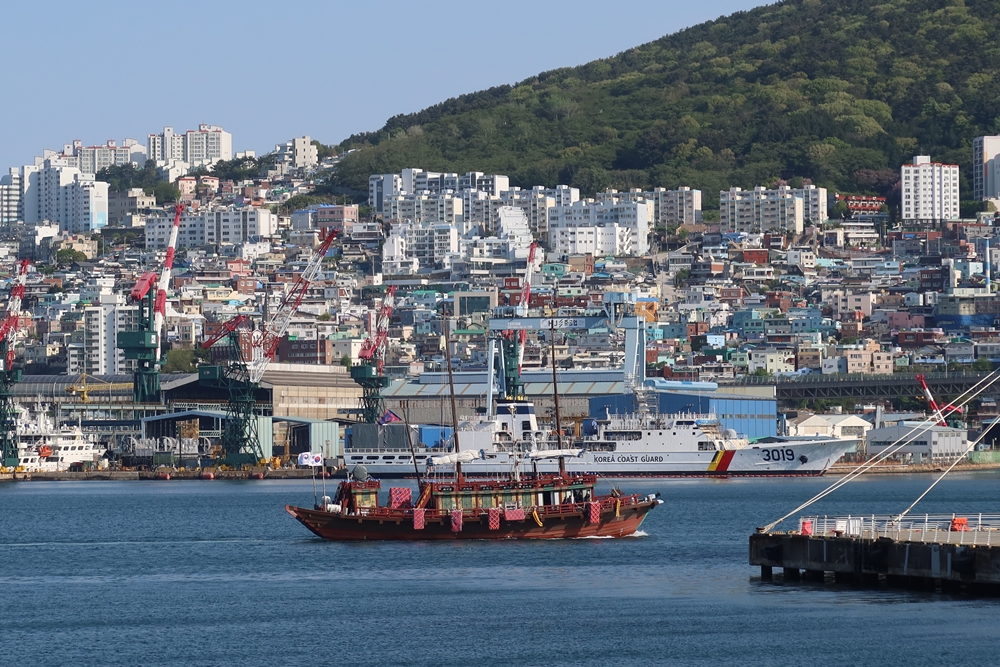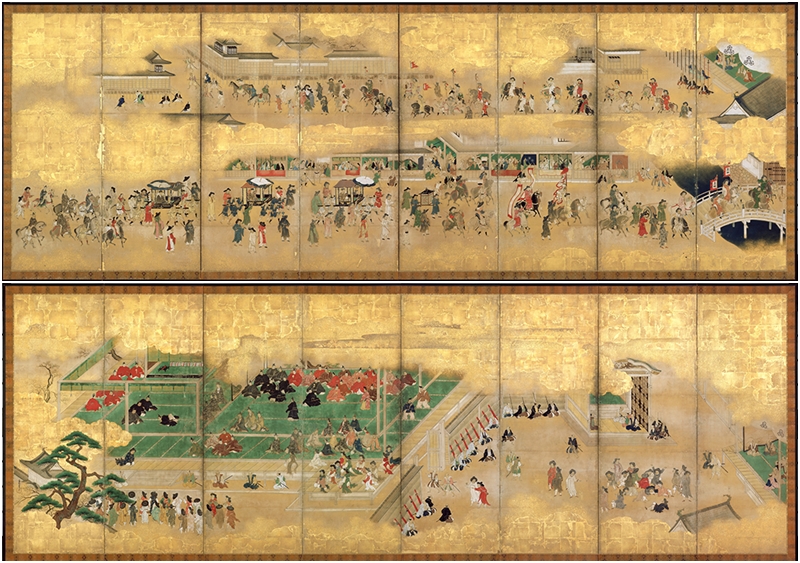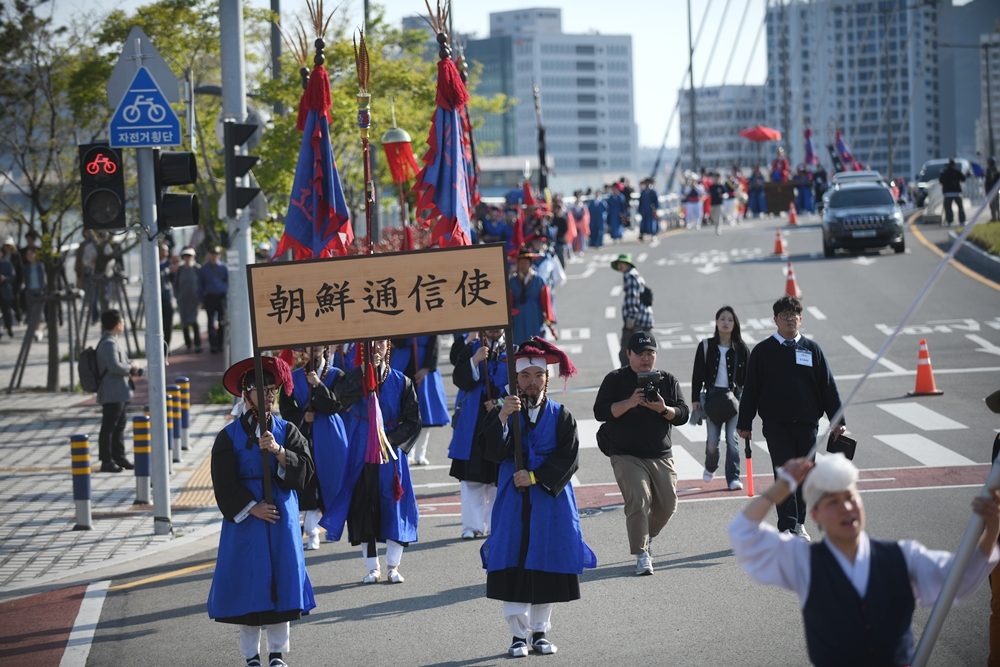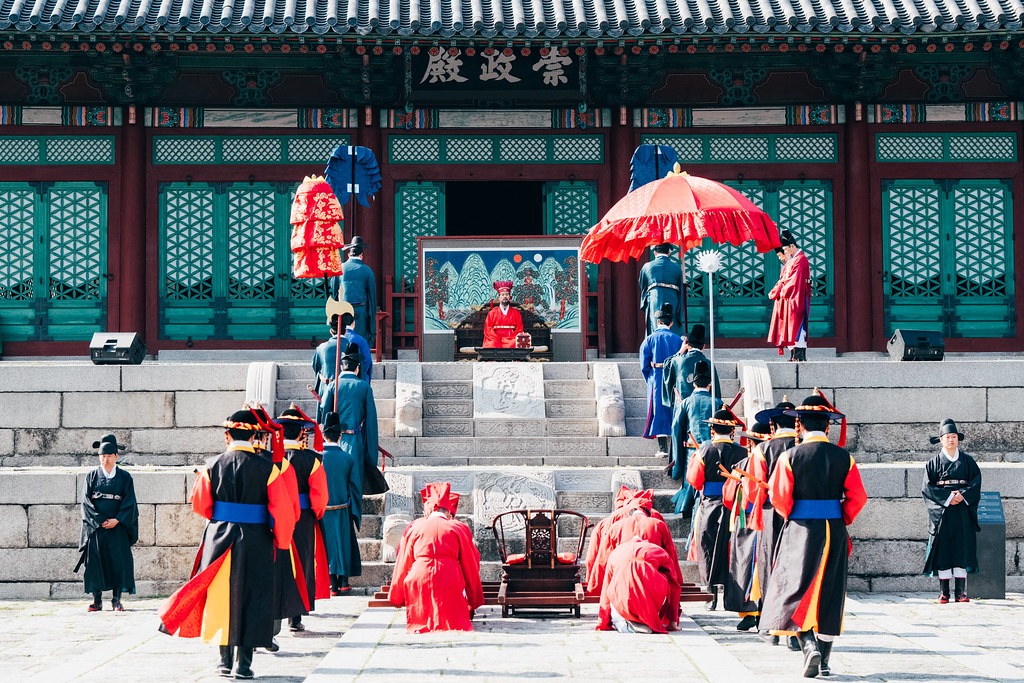
A replica of a ship carrying Tongsinsa, or envoys of the Joseon Dynasty (1392-1910) to Japan from the 17th to 19th centuries, on April 26 sails in front of Yeongdo Island in Busan. Made from pine tree wood from trees in Gangwon-do Province, the ship is 34.5 m long and 9.3 m wide with a mast 22 m tall. (Charles Audouin)
By Charles Audouin
The sea route opened by Tongsinsa, or envoys of the Joseon Dynasty (1392-1910) to Japan, has been reopened.
The Joseon Tongsinsa Ship, which was built in 2018 by the National Research Institute of Maritime Heritage under the Korea Heritage Service, is part of a research project to rebuild traditional ships. Setting sail on April 28 from Busan, it will cross the Korea Strait en route to Kure and Fukuyama, two cities in Japan's Hiroshima prefecture, and on to Tatsuno in Nagano prefecture.
The vessel will drop anchor in Osaka 11 days after its departure in a voyage commemorating the 60th anniversary of the normalization of bilateral ties.

The upper photo shows the UNESCO World Heritage painting "Joseon Tongsinsa Hwandaedo" by Japanese artist Kano Masunobu featuring the welcoming of Tongsinsa, or Joseon Dynasty envoys to Japan. The lower painting displays the envoys' sixth procession and delivery of diplomatic documents. These works through May 25 are displayed at the Seoul Museum of History. (Seoul Museum of History)
Joseon reestablished diplomacy with Japan after the Imjin Waeran, or Japanese invasions of the Korean Peninsula from 1592-98, and sent the envoys 12 times from 1607 to 1811. "Tongsinsa" means "delegation that delivers trust," a term exclusively used to refer to Joseon envoys to Japan, with trust considered the most crucial element of diplomacy.
The delegation comprised 300-500 members including the leader, renowned calligraphers and officials who managed documents of the royal Joseon court.
Members not only performed diplomacy but also cultural exchanges like poetry, calligraphy and paintings and discussed academic topics with scholars from throughout Japan.
In 2017, UNESCO inscribed documents from both countries on Tongsinsa showing 200 years of bilateral peace and cultural exchange on the global body's Memory of the World Register.

Tongsinsa's procession, the main event of the festival, is held on April 26 at Yisunsindaero in Busan's Dong-gu District. (Busan Cultural Foundation)
The final place where Tongsinsa stayed before leaving Joseon was Busan. They departed from Hanyang, the old name for Seoul, passed through Chungju, Chungcheongbuk-do Province, and Mungyeong and Yeongcheon, Gyeongsangbuk-do Province, and arrived in Busan, where they held a ritual to pray for the envoys' safety and a farewell banquet for comfort.
The Busan Cultural Foundation has held the Joseon Tongsinsa Festival for over a decade to mark this tradition.
This year, events from April 25-27 were held in Busan like a ritual to pray for the envoys' safe journey at Beomeosa Temple, a festival for the sea god at Yeongadae Pavilion and a departure ceremony for the vessel at Yongho Starlight Park.
The procession, the highlight of the festival, comprised about 500 people who walked from Busan Port's Pier 1 to North Port Chinsu Park. Through November, the parade will be informally held five more times on Gwangbok-ro Road in Busan's Dong-gu District.

A ceremony for the appointment of three envoys to Japan by the Joseon king on April 24 is reenacted at Gyeonghuigung Palace in Seoul's Jongno-gu District. The real ceremony was held at Changgyeonggung Palace during the Joseon Dynasty (1392-1910). (Busan Cultural Foundation)
Korea and Japan this year are expanding cultural exchanges based on the reenactment of Tongsinsa's sea route.
The Seoul Museum of History is holding a exhibition of about 130 artifacts related to Tongsinsa from both countries. To run until June 29, the display sheds light on friendly bilateral relations formed through the envoys.
On May 13, a ceremony to mark the envoys' arrival and their procession will be reenacted at the pier near Asia and Pacific Trade Center in Osaka on the occasion of Korea Day.
In addition, the National Museum of Korea and Tokyo National Museum will exchange exhibitions of their leading collections. Seoul will host the first display from June to August and Tokyo the second from February to April next year.
caudouin@korea.kr